Social media platforms have become focal points for entertainment, job hunting, marketing, selling, and now customer support. And the primary reason for the latter is simple.
Dropping a complaint on Facebook and tagging the brand responsible attracts public awareness compared to doing the same through emails and calls. Your customers know you care about your brand reputation, and you’d want to resolve the situation as fast as possible before it ruins your business’s image.
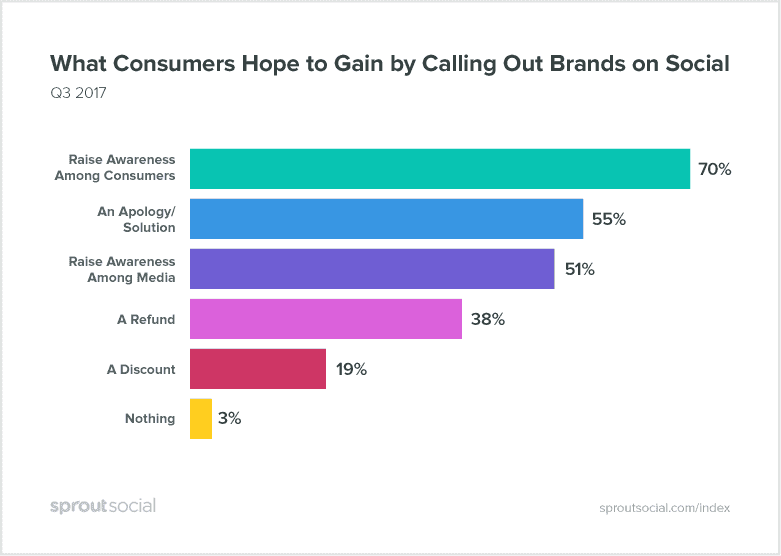
Interestingly, this trend will grow significantly in 2025 as more people turn to social media to call out brands. Therefore, it is essential to put measures in place to avoid getting caught up in the hooks.
In this article, we’ll discuss some expert-proven tips for effectively improving your social media customer support and building a positive brand reputation.
What is Social Media Customer Support?
Social media customer support basically means using social channels like Facebook, X (formerly Twitter), LinkedIn, TikTok, and others to help your customers.
That could be resolving an issue, responding to a query, providing assistance, or even engaging your customers’ user-generated content (UGC) with some humor.
See how FedEx, a global delivery and logistics, did that below.
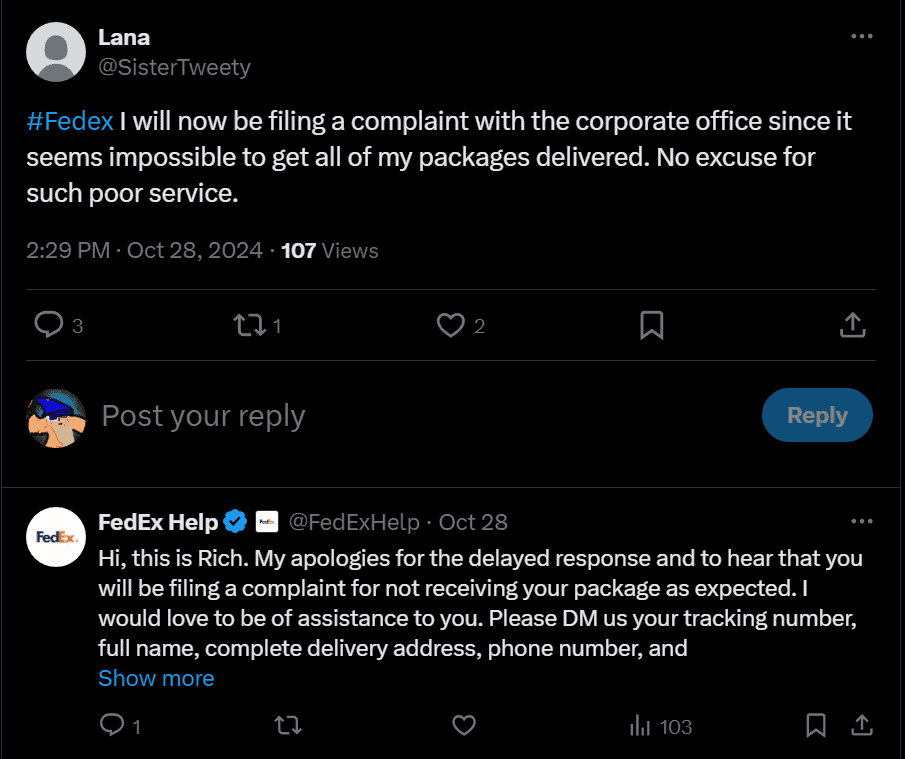
Besides responding to complaints, social media customer support also helps in:
- Collecting customer feedback and insights to improve service delivery.
- Maintaining a constant presence on social media.
All these, in turn, lead to benefits, which we’ll discuss next.
Why is Good Social Media Customer Support Essential?
About 80% of consumers use social media to engage with brands, and 67% of customers find social media more convenient for making complaints.
So, it’s pretty common to see someone call out a brand for poor or delayed delivery, as in the case of TelfarGlobal.

Or to outright discourage the use of a brand:

Worse still, complaints on social media move a mile faster than a bullet train. It takes barely a few hours to see more complaints troop in under an initial post.

Not implementing efficient social media customer support to accurately and quickly address these issues can thus mar your business.
But if you do, you’ll see benefits like enhanced customer satisfaction, improved brand reputation, and reduced support costs.
Enhanced Customer Satisfaction And Loyalty
Good social media support means responding within minutes to a few hours, acknowledging and apologizing for errors when applicable, providing personalized assistance, and finally, solving their pain points.
This results in a positive experience and customer satisfaction. Satisfied customers are also loyal ones, and loyal customers become your most effective brand advocates. 71% of consumers say they will recommend brands that provide a positive experience.
Some go ahead to give you a shoutout on their social media handles.

Improved Brand Reputation
Negative comments about your brand’s products and services are inevitable on social media, even though you should do your best to avoid them. But such comments are not always bad news. First, it shows your prospects you’re not making them up yourself or paying someone to.
Second, managing these comments professionally and helping your customers reach a solution boosts their trust in your ability to handle their pain points. See how Sprout did that below.

Every query you resolve is seen by hundreds or possibly thousands of other customers, boosting your brand reputation while solidifying customer trust.
Reduced Support Costs
Switching to social media customer service support reduces cost per contact by about 83%. That’s reasonable, given that you don’t need to pay expensive phone call service fees or spend more on upgrading your email hosting service to handle growing queries.
It’s just a normal day at the park, where you respond to customers directly on their posts or address their complaints in your social media inbox.
Besides, over 51% of survey respondents say they’re likely to repurchase from a brand that answers their questions on social media. This ultimately boosts your retention rate and reduces customer acquisition costs, whether you’re in the business of wholesale blank hoodies, premium tech gadgets, or specialty beauty products.
5 Tips to Improve Your Business’s Social Media Customer Support in 2025
With over 47% of consumers turning to social media to make their complaints, effective social media customer support is more essential than ever before.
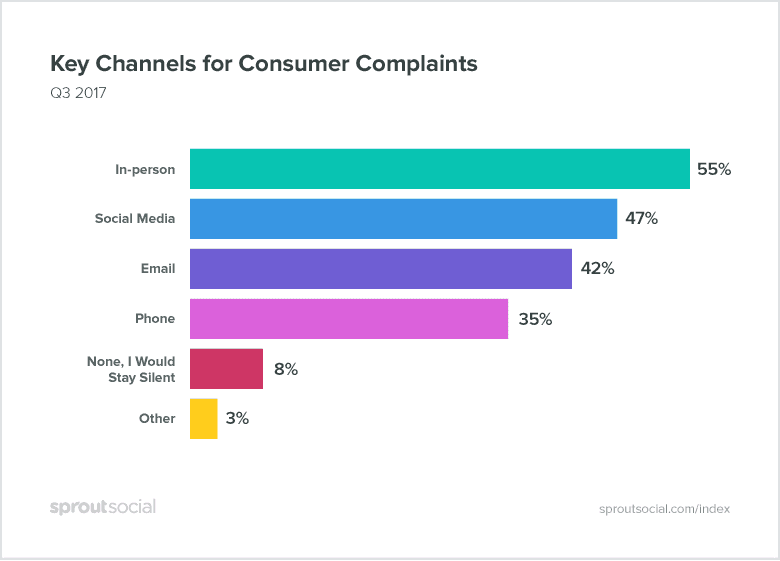
Here are some proven tips to do that.
Personalize Interactions
Generic support services that involve repeating the same crisis management response to your customers will no longer be acceptable in 2025. For instance, imagine sending your customers a “Dear user, thank you for reaching out to us. Can you kindly send us a message via the email below?” each time they tag you on social media to file a complaint.
That’s vague and unhelpful, and it makes your customers feel just like any other person, contrary to the unique way they want you to help them feel. 71% of customers expect you to provide personalized assistance and experience, and over 76% get frustrated when this does not happen.
Frustrated customers will rate their social support experience negatively even if you solve their initial pain point, and that’s not good for your reputation.
To prevent that, embrace hyper-personalization. This includes responding with tailored solutions, referencing past interactions, and showing genuine empathy to make each customer feel valued.
See how Hulu did that below.
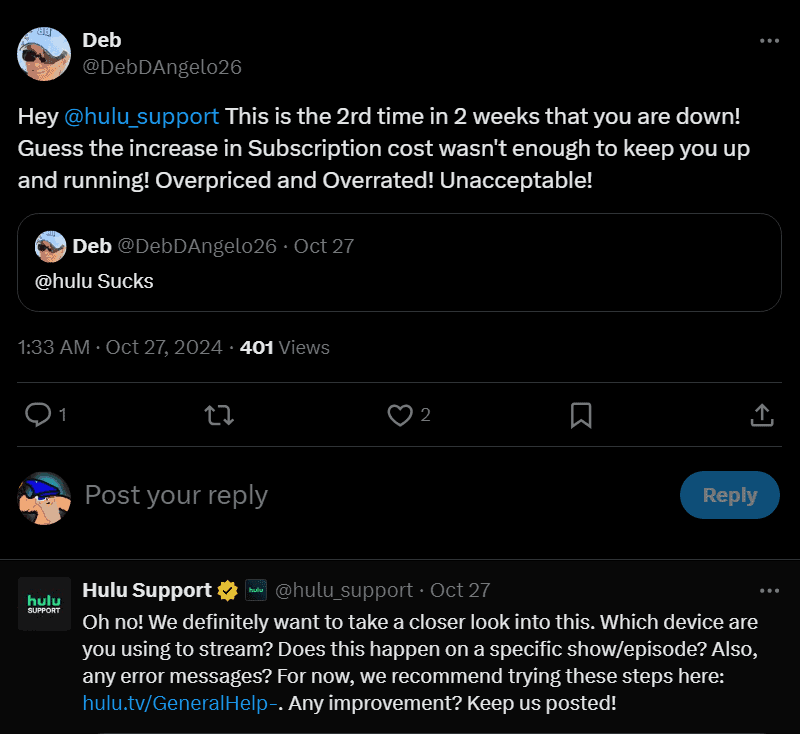
Steps to deliver personalized social media customer support include:
- Use the customer’s name and personalize greetings to make responses feel individual.
- Apologize for the error.
- Acknowledge past interactions by referencing previous issues or orders, showing you remember their history with the brand.
- Tailor responses and solutions specific to the customer’s issue rather than using generic replies.
- Show empathy and understanding by addressing emotional tone and validating their concerns.
Finally, you must follow up post-resolution to ensure satisfaction and encourage feedback for future improvement.
Implement Proactive Support
Jonathan Feniak, General Counsel at LLC Attorney, says, “Proactive customer support primarily doesn’t prevent a problem from happening at all, but it can help you mitigate the spread or reduce damage. For instance, if one user reports an error on social media, you can take measures to uproot the cause before other customers find out the same or engage the post.”
A perfect example of this is from Gucci. There was a complaint about the discriminatory inclusion of the Wool Balaclava. Before more people could join the spike, Gucci quickly took the product down and released a public apology.
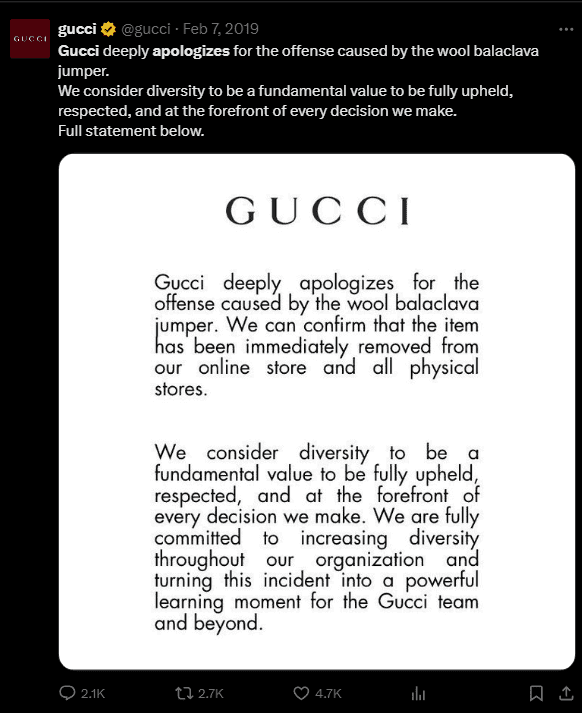
Edward White, Head of Growth at beehiiv, says, “For effective proactiveness to be possible, social listening is essential. Social listening tools monitor social media channels for mentions, conversations, or trends related to a brand. This, in turn, allows your business to track brand sentiment, discover customer concerns, identify trends, and engage proactively.”
To put proactive support in place, do these:
- Choose a comprehensive social listening tool that provides insights into what people say online in real time. Mention.com is an example of such.
- Set up real-time alerts for keywords related to your brand, products, or industry. This will ensure that your team is instantly notified of emerging issues or opportunities for engagement.
- Create response guidelines for common inquiries and complaints to ensure consistent, empathetic responses that align with your brand voice. But embrace flexibility and personalization over guidelines.
- Assign dedicated team members to actively track conversations and address questions or concerns as they arise to build customer trust.
And lastly, integrate social listening data with your CRM for a holistic view of each customer. Connecting insights from social channels with customer data provides context, enabling personalized support and faster issue resolution.
Utilize An Omnichannel Support System
One significant challenge businesses face is a disjointed customer support system. A typical business uses more than three channels—including social media, calls, emails, and web chatbots—to communicate or provide support.
“Things are even worse for social media support. A brand can have as many as five social accounts on different platforms like Facebook, X (formerly Twitter), LinkedIn, etc. However, each account often operates in silo. LinkedIn tabs here, Whatsapp there, emails on another tab”, Mira Nathalea, Chief Marketing Officer at SoftwareHow, says.
This leads to an inconsistent crisis management and support framework across your channels. Besides, not having a single support dashboard to manage your services scatters your customer support resources and leads to inefficiency.
That’s where centralized omnichannel customer support comes in. This strategy centralizes multiple communication channels and your dozen social accounts into a single interface, using tools like Plivo or Freshworks.
And that helps to streamline responses while drastically reducing the chance of missed messages.
To implement omnichannel support, Kyran Schmidt, Co-Founder at Outverse, advises, “Choosing a true omnichannel platform that integrates with your existing channels and accounts. It must also provide seamless connectivity with your CRM and other third-party agents, which is essential for streamlining query resolution.”
Afterward, do the following:
- Map out the customer journey across channels to understand customers’ paths when reaching out for support.
- Centralize customer data and history to allow your support team to work with complete customer histories and respond with relevant context.
- Integrate a social listening tool with your omnichannel platform. Not all customers will reach into your inbox. About 70% will rather call you out through posts just to raise awareness among other customers.
- When an issue can’t be resolved through social media, ask your customers to engage in another comfortable channel.
You have to be particularly careful of enforcing another channel on your customers when they have initially chosen social media to air their grievances. Asking them to send their complaints to a third-party channel adds to the frustration. It’s never a good idea.
See how Geegpay referred a user to their social DM from the feeds instead of asking the user to continue engagement on external channels like email or calls.

Train Support Teams
A billion strategies are as good as none if your support teams lack the prerequisite knowledge and skills to engage customers on social media skillfully. For instance, while some social media complaints could only be as simple as asking for your help, like the Tesla query below…

…others appear abusive, often derogatory and hitting deep at a brand or its workers.
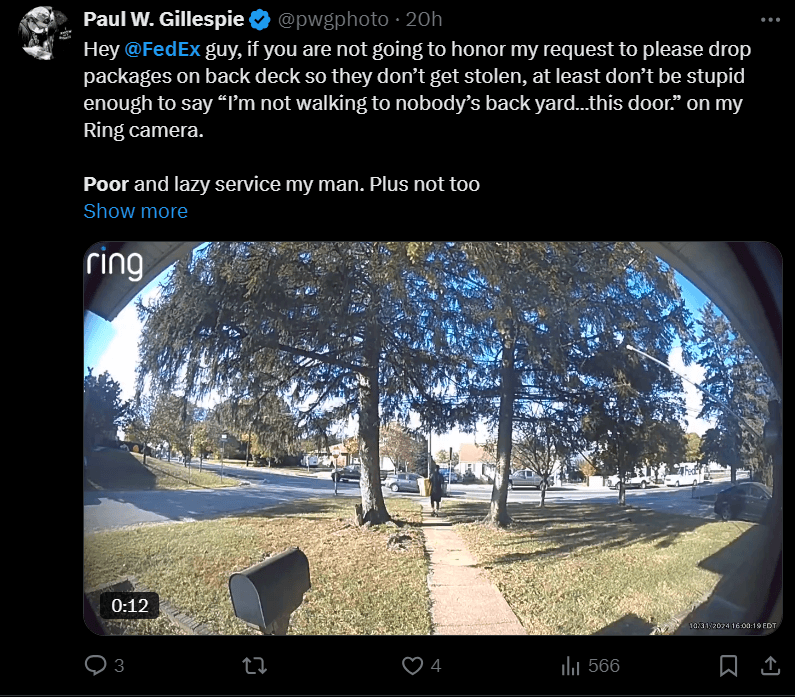
In situations like the latter, a customer support rep with soft skills like listening and empathy is critical to diffusing the situation and even convincing the customer to take down his/her posts.
“Besides, customers turn to social media because they know it’s an avenue to receive faster responses. So, you definitely want a team that can devise solutions within split seconds and resolve customers’ issues on the fly. That’s quick thinking”, Jacob Barnes, Founder of FlowSavvy, adds.
To ensure help our support build the necessary competencies:
- Conduct soft skills training in listening, empathy, and conflict resolution. This is essential to equip your reps with techniques to de-escalate tense situations effectively.
- Run scenario-based role-playing exercises. Real-life social media scenarios will assist your support agents in responding quickly and accurately to challenging customer interactions.
- Provide regular feedback and coaching on social media interactions. This includes reviewing past customer interactions to identify improvement areas and reinforce positive handling strategies.
- Establish clear protocols and permissions for everyday issues to enable your team to resolve problems swiftly and autonomously.
- Design an escalation pathway. Your support members should know when and how to redirect a query they can’t resolve to the next person based on expertise or seniority.
- If you’re engaging cross-border customers, provide multilingual training to address language barriers. The language classes can be online through self-paced tutorials, one-on-one with an instructor, or even physical, covering a range of languages from Koine Greek to Mandarin.
Also, continuous learning on social media trends and individual platform updates should be encouraged. Each platform has peculiar features, inbuilt tools, and best practices that will help them stay agile in customer interactions.
Monitor Growth KPIs
Post-implementation, you should figure out if your strategies are effective or otherwise. This includes looking at how many queries are resolved per support rep and feedback per each resolution. Other metrics you must prioritize are:
- Response Time – Tracks how quickly agents respond to customer inquiries, reflecting agility in customer engagement.
- Resolution Time – Measures the time taken to resolve customer issues fully, showcasing efficiency in support processes.
- Customer Satisfaction (CSAT) Score – Gathers direct feedback from customers on their support experience, indicating quality of service.
- Net Promoter Score (NPS) – Assesses customer likelihood to recommend the brand, often influenced by the quality of customer support.
- First Contact Resolution Rate (FCR) – Measures the percentage of inquiries resolved in the first interaction, signaling support effectiveness and agent competency.
- Volume of Interactions – Monitors the number of inquiries, helps assess demand and staffing needs, and scalability.
- Sentiment Analysis – Analyzes customer sentiment in interactions to gauge brand perception and identify improvement areas in support tone and approach.
“Use insights from your analysis and monitoring to improve your social media customer support delivery. If the response time is too long, figure out why. Your team takes a whole day to resolve a query? Identify the cause and fix it. Overall, your support should get better and almost instantaneous until customers begin to give you shoutouts for a job well-done”, Sabas Lin, CTO at Knowee, explains.
NameCheap is a perfect reference.

Wrapping Up Social Media Customer Support
Social media will undoubtedly become a game-changer for customer support in 2025. Not investing your time and resources in this channel can thus mar your business. Customers’ complaints can go haywire in hours and ruin your brand reputation long before you know it.
But at the same time, social media support can make your business if you do it well. Each query you resolve efficiently reinforces customers’ and audience’s trust in your brand while also reducing your support costs.
To provide excellent social media customer support, personalize every brand-customer or brand-audience interaction. Implement proactive support with social listening tools, unify your social accounts and support channels to streamline support, and train your support teams. Lastly, monitor your growth KPIs and improve existing protocols.

